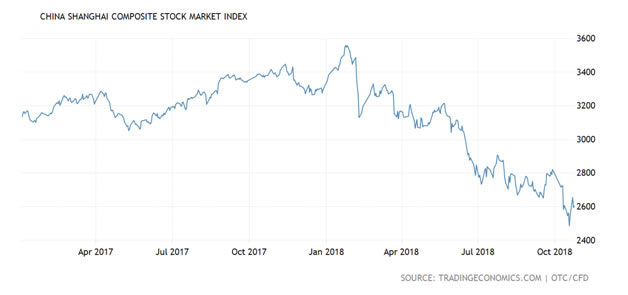Why the Stock Market Crash is Just Beginning
by Michael Pento, Market Oracle:

Wall Street’s playbook stipulates that every down tick in the market is just another buying opportunity. While that is most often true, peak margins, a slowing global economy and the bond bubble collapse makes this time more like 2008 than just a routine selloff.
In the vanguard of this coming market crash is China, whose make-pretend growthrate slid to 6.5% in the third quarter. This is the slowest pace of growth thatthe communist government has been willing to own up tosince the last global financial crisis.Leaving one to conclude that the reality in China is farworse.
This sluggish growth and a near 30% plunge in Shanghai shares prompted swift action from the Chinese government, which announced plans to cut personal income taxes and cut the Reserve Requirement Ratio for the fourth time to encourage more leverage on top of the debt-disabled economy.The government has even bought ETF’s to prop of the sinking Chinese stock market. As a result, shares recently surged 4% in one day. However,more than half of those gains were quickly reversed the following day as investors took a sober look at whether the Chinese government is starting to lose its grip on theeconomy.

According to the Wall Street Journal,investments in Chinese factories and other fixed assets are at their lowest level in 18 years andChina’s usually reliable household consumption is also beginning to decelerate sharply.
China’s economy has been on a downward trajectory in the past few months, with auto and retail sales on the decline. Fixed-asset investment rose a mere 5.3% in the January-August period from a year earlier. It was the most lacklustergrowth rate since 1992. This was mostly a planned slowdown; an edict from the government that realized its economy was beginning to resemble a Ponzi scheme.
What is very interesting is that this lethargic growth persisted even though companies have beengearing up for U.S. tariffs on Chinese products; hence, front-runningpurchases. Macquarie Capital Ltd. predicts that Chinese growthfrom exports will decline as much as 10% in the coming months.
All thisconcern about deceleratinggrowth is hindering China’s deleveraging plans that itpromised to follow through on at the beginning of this year. According to the Financial Times,Chinese debt was in the range of 170% of GrossDomestic Product prior to the Great Recession. But in 2008, China responded to the financial crisis with a huge infrastructure program—building empty cities to the tune of 12.5% of GDP, the biggest ever peacetime stimulus.
According to the Institute for International Finance, China’s gross debt has now exploded to over 300% of GDP. Bloomberg estimates the dollar amount of this debt—both public and private–at $34 trillion; others have it as high as $40 trillion. With a gigantic shadow banking system, this number is obfuscated by design.
Adding to the problem is that much of the Chinese private debt is pledged with collateral from the stock market, which has been in free-fall this year. According to Reuters, more than 637 billion shares valued at $4.44 trillion yuan ($639.86 billion) were pledged for loans as of Oct. 12. As the air continues to pour out of the stock market, it will put additional pressure on the debt market.
Most importantly, China’s debt binge was taken up in record time; soaring by over2,000% in the past 18 years. And thisearth shattering debt spree wasn’t used to generate productive assets. Rather, it was the non-productive, state-directed variety, whichnow requiresa constant stream of new debt to pay off the maturing debt. Therefore, the schizophrenic communist party is caught between the absolute need to deleverage the economy; and at the same time, trying to maintain the growth mirage with additional stimulus measures.
Read More @ MarketOracle.co.uk
Loading...



